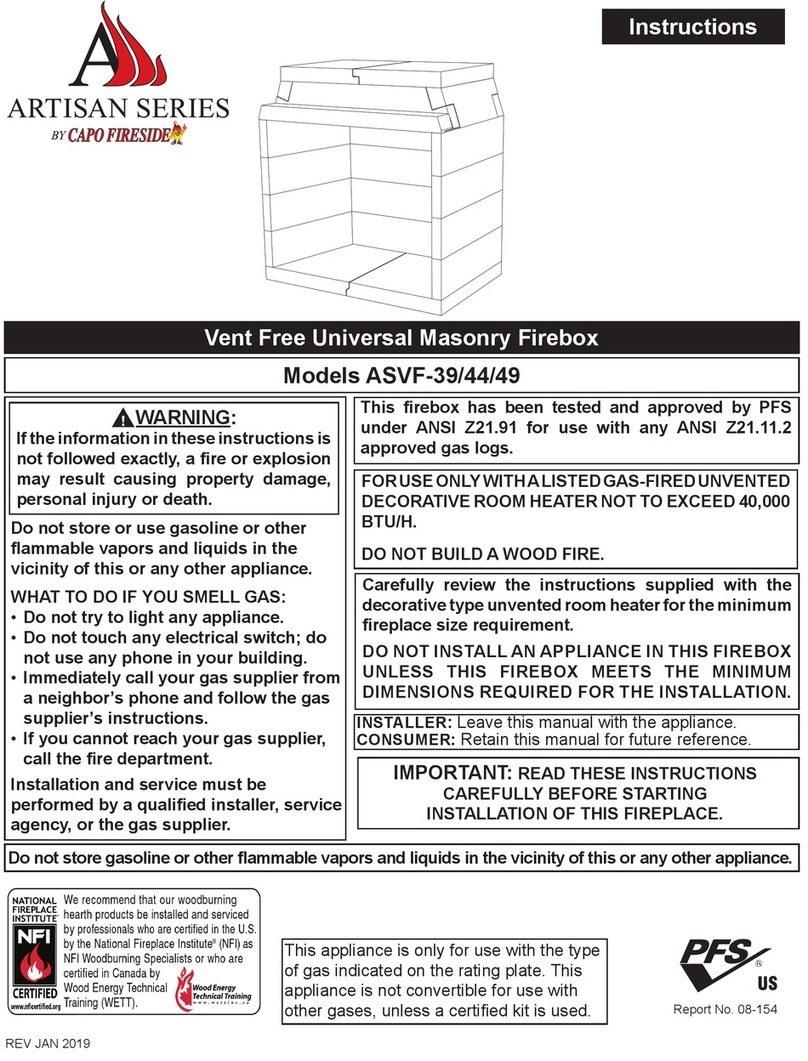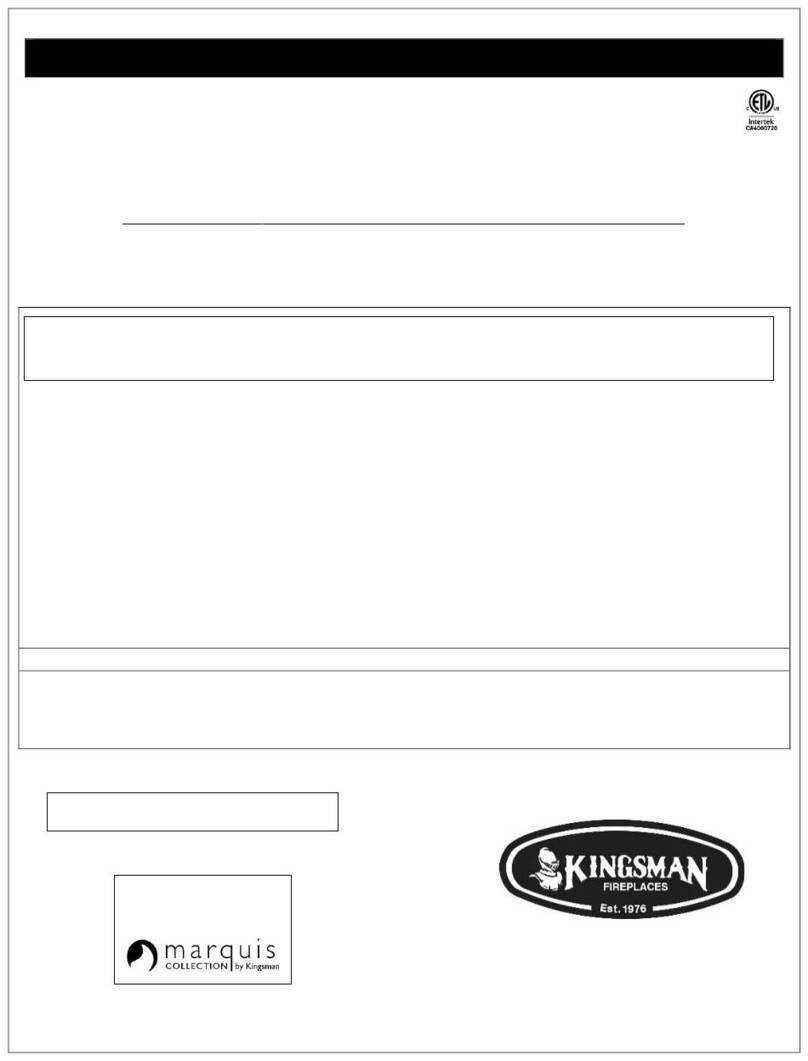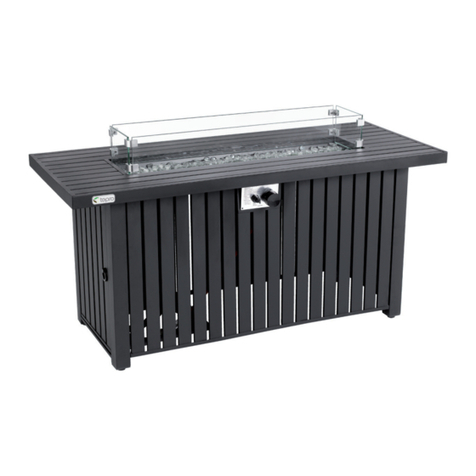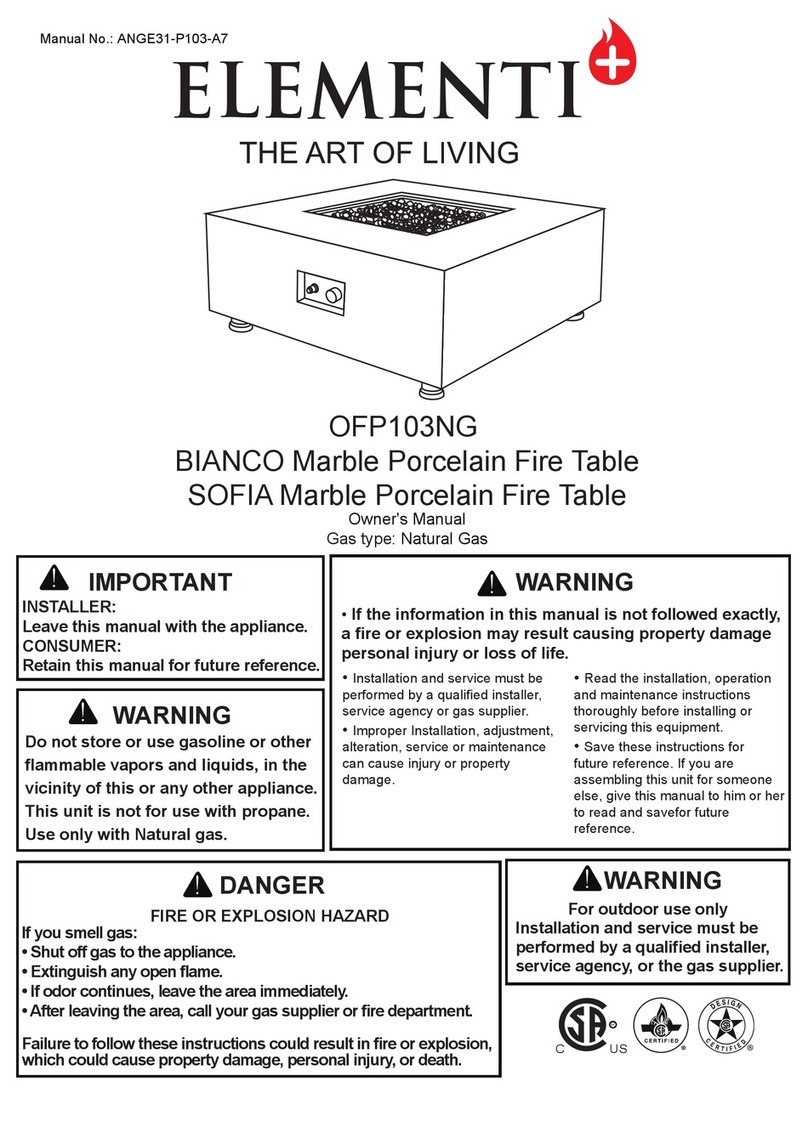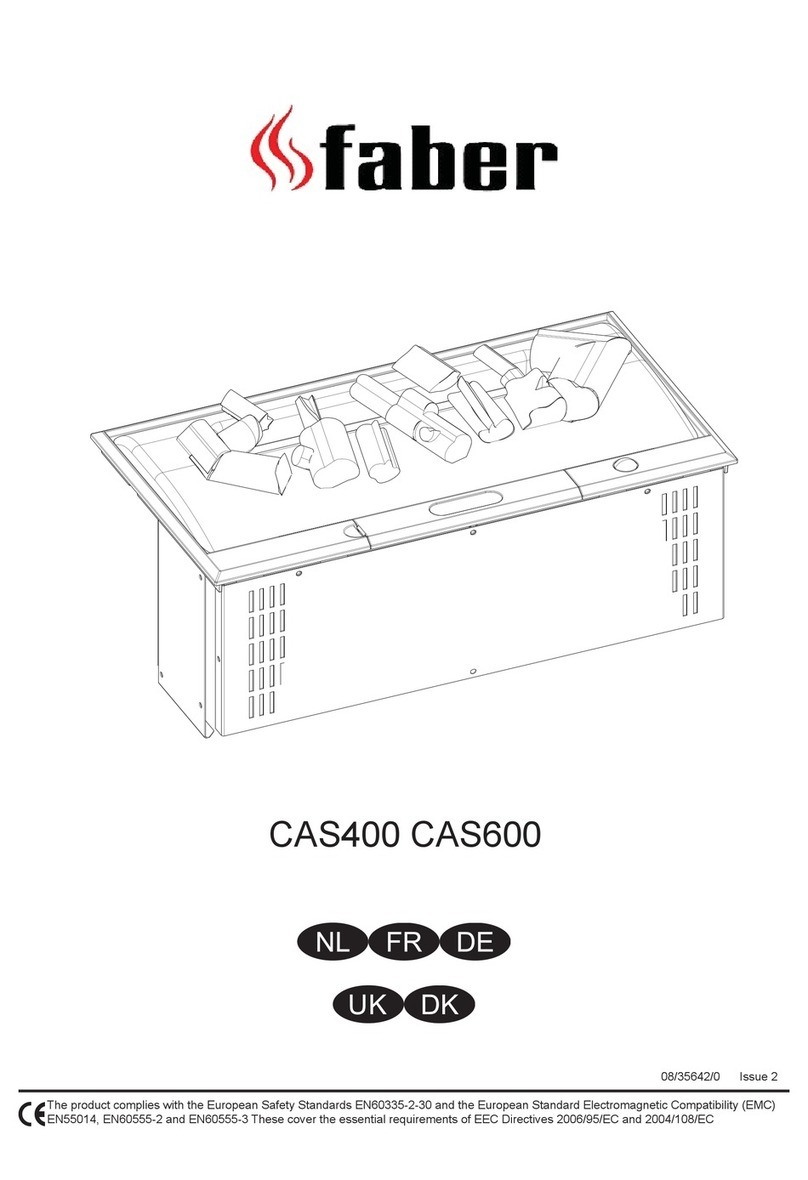O-TL VFF23NLM Quick start guide

UNVENTED (VENT-FREE) DUAL BURNER DUAL FUEL
FIREPLACE OWNER’S OPERATION AND INSTALLATION
MANUAL
INSTALLER: Leave this manual with the appliance.
CONSUMER: Retain this manual for future reference.
— Do not store or use gasoline or other flammable vapors and liquids in the
vicinity of this or any other appliance.
— WHAT TO DO IF YOU SMELL GAS
• Do not try to light any appliance.
• Do not touch any electrical switch; do not use any phone in your building.
• Immediately call your gas supplier from a neighbor’s phone. Follow the gas
supplier’s instructions.
• If you cannot reach your gas supplier, call the fire department.
— Installation and service must be performed by a qualified installer, service
agency or the gas supplier.
WARNING: If the information in this manual is not followed exactly, a fire or
explosion may result causing property damage, personal injury or loss of life.
Model: VFF23NLM

2
TABLE OF CONTENTS
Safety Information .................................................2
Local Codes........................................................... 4
Product Features....................................................5
Product Identification ............................................ 5
Qualified Installing Agency.....................................5
Unpacking.............................................................. 5
Air For Combustion and Ventilation ...................... 6
Installation............................................................. 8
Operating ............................................................17
Specifications ......................................................18
Inspecting Burners ..............................................19
Cleaning and Maintenance .................................20
Troubleshooting.................................................. 21
Replacement Parts ............................................. 25
Technical Service ................................................29
Warranty Information ...........................Back Cover
SAFETY
Fireplace is preset at the factory for propane/LP gas. For natural gas, follow the
simple conversion instructions on page 11.
WARNING: Improper insta-
llation, adjustment, altera-
tion, service or maintenance
can cause injury or property
damage. Refer to this
manual for correct installa-
tion and operational
procedures. For assistance
or additional information
consult a qualified installer,
service agency or the gas
supplier.
WARNING: This is an unve-
nted gas-fired heater. It
uses air (oxygen) from the
room in which it is installed.
Provisions for adequate
combustion and ventilation
air must be provided. Refer
to Air for Combustion and
Ventilation section on page
6 of this manual.
This appliance is only for use with
the type of gas indicated on the
rating plate. This appliance is not
convertible for use with other gases.
This appliance may be installed in an
aftermarket, * permanently located,
manufactured (mobile) home, where
not prohibited by local codes.
* Aftermarket: Completion of sale, not for
purpose of resale, from the manufacturer
WARNING: This product
contains and/or generates
chemicals known to the State of
California to cause cancer or birth
defects or other reproductive harm.
IMPORTANT: Read this owner’s
manual carefully and completely
before trying to assemble, operate
or service this fireplace. Improper
use of this fireplace can cause
serious injury or death from burns,
fire, explosion, electrical shock and
carbon monoxide poisoning.

SAFETY
Continued
Carbon Monoxide Poisoning: Early signs
of carbon monoxide poisoning resemble the
flu, with headaches, dizziness or nausea. If
you have these signs, the fireplace may not
be working properly. Get fresh air at once!
Have fireplace serviced. Some people are
more affected by carbon monoxide than oth-
ers. These include pregnant women, people
with heart or lung disease or anemia, those
under the influence of alcohol and those at
high altitudes.
Natural and Propane/LP Gas: Natural and
Propane/LP gases are odorless.An odor-
making agent is added to these gases. The
odor helps you detect a gas leak. However,
the odor added to the gas can fade. Gas may
be present even though no odor exists.
Make certain you read and understand all
warnings. Keep this manual for reference. It
is your guide to safe and proper operation of
this fireplace.
Due to high temperatures, the
appliance should be located out
of traffic and away from furniture
and draperies.
DANGER: Carbon monoxide
poisoning may lead to death!
WARNING: Any change to this
fireplace or its controls can be
dangerous.
Do not place clothing or other
flammable material on or near the
appliance. Never place any objects
on the fireplace.
Fireplace front and screen become
very hot when running fireplace.
Keep children and adults away
from hot surfaces to avoid burns
or clothing ignition. Fireplace
will remain hot for a time after
shutdown. Allow surfaces to cool
before touching.
Carefully supervise young children
when they are in the same room
with fireplace.
You must operate this fireplace
with the fireplace screen in place.
Make sure fireplace screen is
closed before running fireplace.
Keep the appliance area clear
and free from combustible ma-
terials, gasoline and other flam-
mable vapors and liquids.
1. This appliance is only for use with the
type of gas indicated on the rating plate.
This appliance is not field convertible for
use with other gases.
2. Do not place propane/LP supply tank(s)
inside any structure. Locate propane/LP
supply tank(s) outdoors.
3. If you smell gas
• Shut off gas supply
• Do not try to light any appliance
• Do not touch any electrical switch; do
not use any phone in your building
• Immediately call your gas supplier from
a neighbor’s phone. Follow the gas
supplier’s instructions
• If you cannot reach your gas supplier,
call the fire department
4. This fireplace shall not be installed in a
bathroom.
WARNING: Do not allow fans
to blow directly into the fireplace.
Avoid any drafts that alter burner
flame patterns. Ceiling fans can
create drafts that alter burner flame
patterns. Altered burner patterns
can cause sooting.
3
WARNING: Do not use a blow-
er insert, heat exchanger insert or
other accessory not approved for
use with this heater.

SAFETY
Continued
11. Do not run fireplace
where flammable liquids or vapors are• used or stored.
under dusty conditions.•
12. Do not use this fireplace to cook food or
burn paper or other objects.
13. Never place any objects in the fireplace
or on logs.
14. Do not use fireplace if any part has been
under water. Immediately call a qualified
service technician to inspect the fireplace
and to replace any part of the control
system and any gas control which has
been under water.
15. Turn off and unplug fireplace and let cool
before servicing. Only a qualified service
person should service and repair fireplace.
16. Operating fireplace above elevations of
4,500 feet could cause pilot outage.
17. Do not operate fireplace if log is broken.
Do not operate fireplace if log is chipped
(dime-sized or larger).
18. To prevent performance problems, do
not use propane/LP fuel tank of less than
100 lb. capacity.
19. Provide adequate clearances around air
openings.
LOCAL CODES
Install and use fireplace with care. Follow all
local codes. In the absence of local codes,
use the latest edition of The National Fuel
Gas Code, ANSI Z223.1/NFPA 54*.
*Available from:
American National Standards Institute, Inc.
14 0 Broadway
New York, NY 10018
National Fire Protection Association, Inc.
Batterymarch Park
Quincy, MA 02269
State of Massachusetts: The installation
must be made by a licensed plumber or
gas fitter in the Commonwealth of Mas-
sachusetts.
Sellers of unvented propane or natural
gas-fired supplemental room fireplaces
shall provide to each purchaser a copy of
527CMR 30 upon sale of the unit.
Vent-free gas products are prohibited for
bedroom and bathroom installation in the
Commonwealth of Massachusetts.
4
5. Do not use this fireplace as a wood-burning
fireplace. Use only the logs provided with
the fireplace.
6. Do not add extra logs or ornaments such as
pine cones, vermiculite or rock wool. Using
these added items can cause sooting. Do not
add lava rock around base. Rock and debris
could fall into the control area of fireplace.
7. This fireplace is designed to be smokeless.
If logs ever appear to smoke, turn off fire-
place and call a qualified service person.
Note: During initial operation, slight smok-
ing could occur due to log curing and fire-
place burning manufacturing residues.
8. To prevent the creation of soot, follow the
instructions in Cleaning and Maintenance,
page 23.
9. Before using furniture polish, wax, carpet
cleaner or similar products, turn fireplace
off. If heated, the vapors from these products
may create a white powder residue within
burner box or on adjacent walls or furniture.
10. This fireplace needs fresh air ventilation to
run properly. This fireplace has an Oxygen
Depletion Sensing (ODS) safety shutoff
system. The ODS shuts down the fire-
place if not enough fresh air is available.
See Air for Combustion and Ventilation,
page 6. If fireplace keeps shutting off, see
Troubleshooting, page 24.

PRODUCT IDENTIFICATION
Figure 1 - Vent-Free Compact Dual Flame Fireplace
PRODUCT FEATURES
SAFETY PILOT
This fireplace has a pilot with an Oxygen Deple-
tion Sensing (ODS) safety shutoff system. The
ODS/pilot is a required feature for vent-free
room fireplaces. The ODS/pilot shuts off the
fireplace if there is not enough fresh air.
PIEZO IGNITION SYSTEM
This fireplace has a piezo ignitor. This system
requires no matches, batteries or other sources
to light fireplace.
THERMOSTATIC HEAT CONTROL
Thermostat-Controlled models have a ther-
mostat sensing bulb and a control valve. The
thermostat will automatically modulate the
heat output to maintain a consistent room
temperature. This results in greater fireplace
comfort. This can also result in lower gas
bills.
DUAL GAS TYPE
Simple conversion from propane/LP to
natural gas by a qualified installing agency.
QUALIFIED INSTALLATION AGENCY
Installation and replacement of gas piping,
gas utilization equipment or accessories and
repair and servicing of equipment shall be
performed only by a qualified agency. The
term “qualified agency” means any individual,
firm, corporation, or company that either
in person or through a representative is
engaged in and is responsible for:
a) Installation, testing or replacements of gas
piping or
b) Connection, installation, testing, repair or
servicing of equipment that is experienced
in such work; that is familiar with all pre-
cautions required; and that has complied
with all requirement of the authority having
jurisdiction.
UNPACKING
1. Remove fireplace and hood from carton.
Log is wrapped and inside fireplace. Do
not remove at this time.
2. Remove all protective packaging applied
to fireplace for shipment.
3. Make sure your fireplace includes one
hardware packet.
4. Check fireplace for any shipping damage.
If fireplace is damaged, call Sure Heat
Heating Products at (800) 229-5647 for
replacement parts before returning to dealer.
5

AIR FOR COMBUSTION AND VENTILATION
Today’s homes are built more energy efficient
than ever. New materials, increased insulation
and new construction methods help reduce
heat loss in homes. Home owners weather
strip and caulk around windows and doors
to keep the cold air out and the warm air in.
During heating months, home owners want
their homes as airtight as possible.
While it is good to make your home energy
efficient, your home needs to breathe. Fresh
air must enter your home. All fuel-burning ap-
pliances need fresh air for proper combustion
and ventilation.
Exhaust fans, fireplaces, clothes dryers and
fuel burning appliances draw air from the house
to operate. You must provide adequate fresh
air for these appliances. This will ensure proper
venting of vented fuel-burning appliances.
PROVIDING ADEQUATE
VENTILATION
The following are excerpts from National
Fuel Gas Code, ANSI Z223.1/NFPA 54,
Section 5.3, Air for Combustion and
Ventilation.
All spaces in homes fall into one of the three
following ventilation classifications:
1. Unusually Tight Construction
2. Unconfined Space
3. Confined Space
The information on pages 5 through 7 will
help you classify your space and provide
adequate ventilation.
Unusually Tight Construction
The air that leaks around doors and windows
may provide enough fresh air for combustion
and ventilation. However, in buildings of un-
usually tight construction, you must provide
additional fresh air.
WARNING: This fireplace shall
not be installed in a room or space
unless the requires volume of in-
door combustion air is provided
by the method described in the
National Fuel Gas Code, ANSI
223.1/NFPA 54, the International
Fuel Gas Code, or applicable
local codes. Read the following
instructions to ensure proper fresh
air for this and other fuel-burning
appliances in your home.
Unusually tight construction is defined as
construction where:
a. walls and ceilings exposed to the outside
atmosphere have a continuous water
vapor retarder with a rating of one perm
(6 x 10-11 kg per pa-sec-m ) or less with
openings gasketed or sealed and
b. weather stripping has been added on
openable windows and doors and
c. caulking or sealants are applied to areas
such as joints around window and door
frames, between sole plates and floors,
between wall-ceiling joints, between wall
panels, at penetrations for plumbing, electri-
cal and gas lines and at other openings.
If your home meets all of these three criteria,
you must provide additional fresh air. See
Ventilation Air From Outdoors, page 8.
If your home does not meet all of the three
criteria above, proceed to Determining Fresh-
Air Flow For Fireplace Location.
Confined and Unconfined Space
The National Fuel Gas Code, ANSI Z223.1/
NFPA 54 defines a confined space as a space
whose volume is less than 50 cubic feet per
1,000 Btu/hr (4.8 m3 per kw) of the aggregate
input rating of all appliances installed in that
space and an unconfined space as a space
whose volume is not less than 50 cubic feet per
1,000 Btu/hr (4.8 m3 per kw) of the aggregate
input rating of all appliances installed in that
space. Rooms communicating directly with the
space in which the appliances are installed*,
through openings not furnished with doors, are
considered a part of the unconfined space.
* Adjoining rooms are communicating only if
there are doorless passageways or ventilation
grills between them.
DETERMINING FRESH-AIR FLOW FOR
FIREPLACE LOCATION
Determining if you have a Confined or
Unconfined Space
Use this work sheet to determine if you have
a confined or unconfined space.
Space: Includes the room in which you will
install fireplace plus any adjoining rooms with
doorless passageways or ventilation grills
between the rooms.
1. Determine the volume of the space (length x
width x height).
Length x Width x Height =__________cu. ft.
(volume of space)
6

WARNING: If the area in which
the heater may be operated does
not meet the required volume for
indoor combustion air, combus-
tion and ventilation air shall be
provided by one of the methods
described in the National Fuel
Gas Code, ANSI Z223.1/NFPA 54,
the International Fuel Gas Code,
or applicable local codes.
If the actual Btu/Hr used is less than the maxi-
mum Btu/Hr the space can support, the space
is an unconfined space. You will need no
additional fresh air ventilation.
Confined and Unconfined Space
AIR FOR COMBUSTION AND VENTILATION
Continued
Example: Space size 16 ft. (length) x 14 ft.
(width) x 8 ft. (ceiling height) = 1792 cu. ft.
(volume of space)
If additional ventilation to adjoining room
is supplied with grills or openings, add the
volume of these rooms to the total volume
of the space.
2. Multiply the space volume by 20 to
determine the maximum Btu/Hr the space
can support.
________ (volume of space) x 20 = (Maxi-
mum Btu/Hr the space can support)
Example: 1792 cu. ft. (volume of space) x
20 = 35,840 (maximum Btu/Hr the space
can support)
3. Add the Btu/Hr of all fuel burning appliances
in the space.
Vent-free fireplace __________Btu/Hr
Gas water heater* __________Btu/Hr
Gas furnace __________Btu/Hr
Vented gas heater __________Btu/Hr
Gas fireplace logs __________Btu/Hr
Other gas appliances* + _________Btu/Hr
Total = _________Btu/Hr
* Do not include direct-vent gas appliances.
Direct-vent draws combustion air from the
outdoors and vents to the outdoors.
Example:
Gas water heater __________Btu/Hr
Vent-free fireplace __________Btu/Hr
Total __________Btu/Hr
4. Compare the maximum Btu/Hr the space
can support with the actual amount of Btu/Hr
used.
_______ Btu/Hr (maximum space cansupport)
______ Btu/Hr (actual amount used)
Example: 35,840 Btu/Hr (maximum the space
can support)
56,000 Btu/Hr (actual amount of
Btu/Hr used)
The space in the previous example is a
confined space because the actual Btu/Hr used
is more than the maximum Btu/Hr the space
can support. You must provide additional fresh
air. Your options are as follows:
A. Rework worksheet, adding the space of an
adjoining room. If the extra space provides
an unconfined space, remove door to adjoin-
ing room or add ventilation grills between
rooms. See Ventilation Air From Inside
Building.
B. Vent room directly to the outdoors. See
Ventilation Air From Outdoors, page 8.
C. Install a lower Btu/Hr fireplace, if lower Btu/
Hr size makes room unconfined.
VENTILATION AIR
Ventilation Air From Inside Building
This fresh air would come from an adjoining
unconfined space. When ventilating to an
adjoining unconfined space, you must provide
two permanent openings: one within 12” ( 0.5
cm) of the ceiling and one within 12” (30.5
cm) of the floor on the wall connecting the two
spaces (see options 1 and 2, Figure 2, page
7). You can also remove door into adjoining
room (see option 3, Figure 2, page 7). Follow
the National Fuel Gas Code, ANSI Z223.1/
NFPA 54, Section 5.3, Air for Combustion and
Ventilation for required size of ventilation grills
products.
Figure 2 - Ventilation Air from Inside
Building
7

INSTALLATION
Ventilation Air From Outdoors
Provide extra fresh air by using ventilation
grills or ducts. You must provide two perma-
nent openings: one within 12” ( 0.5 cm) of
the ceiling and one within 12” ( 0.5 cm) of
the floor. Connect these items directly to the
outdoors or spaces open to the outdoors.
These spaces include attics and crawl
spaces. Follow the National Fuel Gas Code,
ANSI Z223.1/NFPA 54, Section 5.3, Air for
Combustion and Ventilation for required size
of ventilation grills or ducts.
IMPORTANT: Do not provide openings for
inlet or outlet air into attic if attic has a thermo-
stat-controlled power vent. Heated air entering
the attic will activate the power vent. Figure 3 - Ventilation Air from Outdoors
NOTICE: This fireplace is intended
for use as supplemental heat.
Use this fireplace along with your
primary heating system. Do not
install this fireplace as your pri-
mary heat source. If you have a
central heating system, you may
run system’s circulating blower
while using fireplace. This will help
circulate the heat throughout the
house. In the event of a power
outage, you can use this fireplace
as your primary heat source.
IMPORTANT: Vent-free fireplaces add mois-
ture to the air. Although this is beneficial,
installing fireplace in rooms without enough
ventilation air may cause mildew to form
from too much moisture. See Air for
Combustion and Ventilation, page 6.
Note: Your fireplace is designed to be
used in zero clearance installations. Wall
or framing material can be placed directly
against any exterior surface on the rear,
sides or top of your fireplace, except where
standoff spacers are integrally attached.
If standoff spacers are attached to your
fireplace, these spacers can be placed
directly against wall or framing materials.
WARNING: Never install in a
bedroom or bathroom. Any heating
product with a Btu/Hr rating over
10,000 cannot be used in a bedroom.
WARNING: A qualified ser-
vice person must install fireplace.
Follow all local codes.
WARNING: Never install the
fireplace
• in a bathroom
• in a recreational vehicle
• where curtains, furniture,
clothing or other flammable
objects are less than 36”
(91.5 cm) from the front, top
or sides of the fireplace
• as a fireplace insert
• in high traffic areas
• in windy or drafty areas
AIR FOR COMBUSTION AND VENTILATION
Continued
CAUTION: This fireplace cre-
ates warm air currents. These cur-
rents move heat to wall surfaces
next to fireplace. Installing fireplace
next to vinyl or cloth wall coverings
or operating fireplace where impu-
rities (such as, but not limited to,
tobacco smoke, aromatic candles,
cleaning fluids, oil or kerosene
lamps, etc.) in the air exist, may
discolor walls or cause odors.
8

INSTALLATION ITEMS
Before installing fireplace, make sure you
have the items listed below.
external regulator (supplied by installer, for• propane/LP units only)
piping (check local codes)• sealant (resistant to propane/LP gas)• equipment shutoff valve *• test gauge connection*• ground joint union• sediment trap• tee joint• pipe wrench•
* An CSAdesign-certified equipment shutoff
valve with 1/8” NPT tap is an acceptable al-
ternative to test gauge connection. Purchase
the optional CSAdesign-certified equipment
shutoff valve from your dealer.
INSTALLATION
Continued
Note: When installing fireplace directly on
carpeting, tile or other combustible material,
other than wood flooring, the fireplace shall be
installed on a metal or wood panel extending
the full width and depth of the fireplace.
Use the dimensions shown for rough openings
to create the easiest installation (see Built-In
Fireplace Installation, page 11).
CHECK GAS TYPE
Use only the correct gas type (natural or
propane/LP) for your unit. If you do not know
your gas type, do not install heater. The heater
leaves the factory set for propane/LP gas. If
natural gas is desired, a qualified installer can
perform the simple conversion to natural gas
by following the instructions on page 13.
WARNING: This appliance
is equipped for natural and
propane/LP. Gas type is indicated
ontheratingplate.Field conversion
isnotpermittedotherthanbetween
natural or propane gases.
WARNING: Always have
hood in place before operating
fireplace. This prevents excessive
temperatures on fireplace surfaces.
WARNING: Failure to position
the parts in accordance with these
diagrams or failure to use only
parts specifically approved with
this fireplace may result in property
damage or personal injury.
Figure 4 - Removing and Replacing
Screen (Mantel Not Shown)
9
Tools Required:
• Phillips screwdriver • slotted screwdriver
• 5/16” hex wrench • scissors
1. Lift fireplace screen up and pull out to
remove (See Figure 4), Set screen aside
until installation has been complete.
2. Remove all packaging from inside of unit.
3. Remove bubble wrap from logs and discard.
4. Check installation of brick liners. Brick liners
are in 4 pieces: 2 sides, 1 back and 1 top.
FlREPLACE CLEARANCES
Minimum Clearances For Side Combustible
Material, Side WalI and Ceiling
A. Clearances from the side of the fireplace
cabinet to any combustible material and wall
should foIlow diagram in Figure 5.
Example: The face of a mantel, bookshelf
etc is made of combustible materiaI
and protrudes 3 1/2” from the wall. This
combustible materiaI must be 4” from the
side of the fireplace opening (see Figure 5).
B. Clearances from the top of the fireplace
opening to the ceiling should not be Iess
than 36”.
C. For mantel clearances, see Figure 8 on
page 13.

Figure 5 - Minimum Clearance for
Combustible to Wall
MINIMUM CLEARANCE TO
COMBUSTIBLE MATERIALS
Top 36”, Left and Right Sides 6”,
Bottom and Rear 0”, Front 36”
*Minimum 16” from Side Wall
INSTALLATION
Continued
NOTlCE: Surface temperatures of
adjacent walls and mantels become
hot during operation. Walls and
mantels above the firebox may
become hot to the touch. If installed
properly, these temperatures meet
the requirement of the national
product standard. Follow minimum
clearances shown in this manual.
1. ManteI must be installed flush with wall
Base board must be altered or removed
for mantel installation.
2. Place hearth base against wall at instaI-
lation Iocation. Cut an access hole in
hearth base to run gas line to fireplace
fsee Figure 6). Make sure to locate access
hole to inside of mantel.
Note: You can secure base to floor using
wood screws. Counter sink screw heads
and putty over.
3. Route flexible gas line through access
hole in hearth base.
WARNING: Do not allow any
combustible or noncombustible
materials to overlap the firebox front
facing.
WARNING: Never modify or
cover the Iouvered slots on the front
of the firebox.
WARNING: Do not allow non-
combustible materials to cover any
necessary openings like Iouvered
slots.
Figure 6 - Locating Gas Shutoff Valve
10
FIREPLACE SYSTEM lNSTALLATION
Follow these instructions for system installa-
tion. Refer to instructions on page 6 for hood
assembly.
CAUTION: Two gas line
installations at the same time are
forbidden. Do not open or access
the selector valve while heater is
operating.
GAS SELECTION
Heater is preset at the factory for propane/
LP gas. No changes are required for con-
necting fireplace to a propane/LP gas
supply. Only a qualified installer or service
technician can perform gas selection and
connecting to gas supply.
For Propane/LP Gas
1. Mark on rating label propane/LP gas.
2. No other actions needed.

Changing from Propane/LP Gas to
Operation on Natural Gas
Carefully remove logs. Loosen the 3 screws1. on the top of the firebox back. (See Figure
7) and remove the hood top and fire brick
top from firebox. Remove the 2 screws on
the top of the fire brick left and right. Then
remove fire bricks from the firebox. (See
Figure 8)
INSTALLATION
Continued
Figure 8 - Removing Floor Assembly
Figure 9 - Changing Gas Type
6. Remove set screw from selector valve
linkage (see Figure 10, page 12).
7. Slightly press selector plate and rotate
linkage clockwise until it stops.
8. Reinstall set screw.
9. Mark on rating label natural gas.
Note: Slot in linkage will indicate the type
of gas selected. Blue color code on linkage
decal will indicate correct setting for natural
gas.
10.Place floor assembly inside firebox.
Connect to gas supply and check for leaks
(see page 13). Replace screws securing
floor assembly to firebox.
11.Replace fire bricks into firebox and secure
the screws. Replace logs into firebox.
Flex Line
Regulator
Figure 9 - 1
Figure 9 - 2
Figure 9 - 3
Figure 9 - 4
Cap
LP to NG Setting NG to LP Setting
Figure 9 - 5
Figure 9 - 6
Figure 9 - 7
Figure 9- 8
Cap
White Plastic
Screw
Cap
White Plastic
Screw
Flex Line
Floor Assembly
6 Screws
11
Fire bricks
2 Screws
2. Remove 6 screws securing floor assembly
to firebox (see Figure 8).
3. Carefully remove floor assembly from
inside firebox.Carefully turn floor assembly
over so com- ponents underneath floor are
accessible from the rear. Remove the cap
by hand from the regulator and now the
white plastic screw is in the LP position.
(see Figure 9-1).
4. Remove the white plastic screw by hand
from the cap. (See Figure 9-2)
5. Turn it over (See Figure 9-3) and reinstall it
on the cap (See Figure 9-4). Make sure the
white plastic screw is installed on the cap
tightly. Reinstall the cap to the regulator.
Figure 7 - Removing Fire Bricks
3 Screws

Propane/LP Gas Setting
Figure 10 - Gas Selector Valve Plate
Natural Gas Setting
INSTALLATION
Continued
Changing from Natural Gas to
Operation on Propane/LP Gas (for
Previously Installed Log Sets)
Carefully remove logs. Loosen the 3 screws1. on the top of the firebox back. (See Figure
7) and remove the hood top and fire brick
top from firebox. Remove the 2 screws on
the top of the fire brick left and right. Then
remove fire bricks from the firebox. (See
Figure 8)
Remove the screws securing floor assembly2. to firebox (see Figure 8, page 11). Carefully
remove floor assembly from inside firebox.
Carefully turn floor assembly over so3. components underneath floor are acces-
sible from the rear. Remove the cap by
hand from the regulator and now the white
plastic screw is in the NG position. (see
Figure 9-5).
Remove the white plastic screw by hand4. from the cap. (See Figure 9-6)
5. Turn it over (See Figure 9-7) and reinstall it
on the cap (See Figure 9-8). Make sure the
white plastic screw is installed on the cap
tightly. Reinstall the cap to the regulator.
6. Remove set screw from selector valve
linkage (see Figure 10).
7. Slightly press selector plate and rotate
linkage counterclockwise until it stops.
8. Reinstall set screw.
9. Mark on rating label propane/LP gas.
Note: Slot in linkage will indicate the type
of gas selected. Red color code on linkage
decal will indicate correct setting for
propane/LP gas.
10.Place floor assembly inside firebox.
Connect to gas supply and check for leaks
(see Connecting to Gas Supply, page 16).
Replace screws securing floor assembly to
firebox.
11.Replace fire bricks into firebox and secure
the screws. Replace logs into firebox.
12
Selector
Valve Plate
Set Screw
Linkage
Selector
Valve Plate
Linkage Set Screw

CONNECTING TO GAS SUPPLY
WARNING: A qualified service
person must connect fireplace to gas
supply. Follow all local codes.
WARNING: Never connect
natural gas fireplace to private
(non-utility) gas wells. This gas is
commonly known as wellhead gas.
IMPORTANT: For natural gas, check gas line
pressure before connecting fireplace to gas
line. Gas line pressure must be no greater
than 14” of water. If gas line pressure is higher,
heater regulator damage could occur.
CAUTION: Never connect
propane/LP fireplace directly to the
propane/LP supply. This fireplace
requires an external regulator (not
supplied).Installtheexternalregulator
between the fireplace and propane/LP
supply.
INSTALLATION
Continued
For propane/LP units, the installer must supply
an external regulator. The external regulator
will reduce incoming gas pressure. You must
reduce incoming gas pressure to between
11” and 14” of water. If you do not reduce
incoming gas pressure, fireplace regulator
damage could occur. Install external regula-
tor with the vent pointing down as shown in
Figure 11. Pointing the vent down protects it
from freezing rain or sleet.
CAUTION: Use only new,
black iron or steel pipe. Internally-
tinned copper tubing may be used in
certain areas. Check your local codes.
Use pipe of 1/2” or greater diameter to
allow proper gas volume to fireplace.
If pipe is too small, undue loss of
volume will occur.
Figure 11 - External Regulator With Vent
Pointing Down
13
Installation must include an equipment shutoff
valve, union and plugged 1/8” NPT tap. Locate
NPT tap within reach for test gauge hook up.
NPT tap must be upstream from heater (see
Figure 16).
IMPORTANT: Install equipment shutoff valve
in an accessible location. The equipment
shutoff valve is for turning on or shutting off
the gas to the appliance.
Check your building codes for any special
requirements for locating equipment shutoff
valve to fireplaces.
Apply pipe joint sealant lightly to male NPT
threads. This will prevent excess sealant from
going into pipe. Excess sealant in pipe could
result in clogged fireplace valves.
WARNING: Use pipe joint
sealant that is resistant to liquid
petroleum (LP) gas.
WARNING: This appliance
requires a 5/8” UNF and 1/2” NPT
fitting (Unified National Fine Thread)
inlet connection and the flexible gas
line provided.

INSTALLATION
Continued
Figure 11 - Gas Connection
CONNECTING EQUIPMENT SHUTOFF
VALVE TO HEATER CONTROL
Installation Items Needed
• Phillips screwdriver
• Sealant (resistant to propane/LP gas, not
provided)
1. Open lower louver (see Figure 13).
NOTICE: Most building codes do not
permit concealed gas connections. A
flexible gas line is provided to allow
accessibility from the fireplace (see
Figure 17). The flexible gas supply line
connection to the equipment shutoff
valve should be accessible.
2. Route flexible gas line, included, from
fireplace control to equipment shutoff valve
through side access holes in outer casing.
3. Apply pipe joint sealant lightly to male
threads of gas connector attached to
flexible gas line/equipment shutoff valve
(see Figure 14).
Figure 13 - Flexible Gas Line Location
CSA Design-Certified
Equipment Shutoff Vavle
With 1/8” NPT Tap
Figure 14 - Attaching Flexible Gas Line
to Equipment Shutoff Valve
4. Check all gas connections for leaks. See
Checking Gas Connections below. Feed
flexible gas line into fireplace. Make sure
the entire flexible gas line is in fireplace.
CHECKING GAS CONNECTIONS
WARNING: Test all gas piping
and connections, internal and exter-
nal to unit, for leaks after installing or
servicing. Correct all leaks at once.
WARNING: Never use an open
flame to check for a leak. Apply a
noncorrosive leak detection fluid to all
joints. Bubbles forming show a leak.
Correct all leaks at once.
7”
Flexible
Gas Line
Lower
Louver
14
We recommend that you install a sediment
trap in supply line as shown in Figure 12.
Locate sediment trap where it is within reach
for cleaning. Install in piping system between
fuel supply and heater. Locate sediment
trap where trapped matter is not likely to
freeze. A sediment trap traps moisture and
contaminants. This keeps them from going
into fireplace controls. If sediment trap is not
installed or is installed wrong, fireplace may
not run properly.

PRESSURE TESTING GAS SUPPLY
PIPING SYSTEM
Test Pressures In Excess Of 1/2 PSIG
(3.5 kPa)
1. Disconnect appliance with its appliance
main gas valve (control valve) and equip-
ment shutoff valve from gas supply piping
system. Pressures in excess of 1/2 psig
will damage fireplace regulator.
2. Cap off open end of gas pipe where equip-
ment shutoff valve was connected.
3. Pressurize supply piping system by either
opening propane/LP supply tank valve
for propane/LP gas or opening main gas
valve located on or near gas meter for
natural gas or using compressed air.
4. Check all joints of gas supply piping system.
Apply a noncorrosive leak detection fluid to
all joints. Bubbles forming show a leak.
5. Correct all leaks at once.
6. Reconnect fireplace and equipment shutoff
valve to gas supply. Check reconnected
fittings for leaks.
Test Pressures Equal To or Less Than
1/2 PSIG (3.5 kPa)
1. Close equipment shutoff valve (see Figure 15).
2. Pressurize supply piping system by either
opening propane/LP supply tank valve
for propane/LP gas or opening main gas
valve located on or near gas meter for
natural gas or using compressed air.
INSTALLATION
Continued
Figure 15 - Equipment Shutoff Valve
CAUTION: For propane/LP gas,
make sure external regulator has been
installed between propane/LP supply
and fireplace. See guidelines under
Connecting to Gas Supply, page 11.
CAUTION: Make sure external
regulator has been installed between
propane/LP supply and fireplace. See
guidelines under Connecting to Gas
Supply, page 14.
15
PRESSURE TESTING FIREPLACE GAS
CONNECTIONS
1. Open equipment shutoff valve (see Figure
15, page 15).
2. Open main gas valve located on or near
gas meter for natural gas or open pro-
pane/LP supply tank valve.
3. Make sure control knob of fireplace is in
the OFF position.
4. Check all joints from equipment shutoff
valve to gas regulator (see Figure 16 or
17). Apply noncorrosive leak detection
fluid to all joints. Bubbles forming show a
leak.
5. Correct all leaks at once.
6. Light fireplace (see Operation, page 17).
Check all other internal joints for leaks.
7. Turn off fireplace (see To Turn Off Gas to
Appliance, page 19).
Figure 16 - Checking Gas Joints
(Propane/LP Only)

INSTALLATION
Continued
INSTALLING LOG SET AND SCREEN
1. Remove log packaging material and discard
packaging. Gently place log over the burner
(see Figure 18). Do not allow log to contact
flame. If flame contacts log, soot will be
created.
2. Reattach screen by placing the notches
in the screen frame over the shoulder
screws and pushing down.
Figure 17 - Checking Gas Joints
(Natural Gas Only)
Figure 18 - Installing Log and Screen
16
INSTALLING MANTEL
1. Remove all the foam in the firepace.
2. Insert top trim panel to the top of side panel
trim.
3. Use two self-tapping screws to secure the
top trim panel to mantal.
4. Use eight self-tapping screws to secure
burner assembly to the mantel.
(see Figure 19)
Figure 19 - Installing Mantel
Top Trim Panel
2 Self-tapping Screws

1. STOP! Read the safety information.
2. Make sure equipment shutoff valve is
fully open.
3. Turn control knob clockwise to the
OFF position.
4. Wait five (5) minutes to clear out any gas.
Then smell for gas, including near the
floor. If you smell gas, STOP! Follow “B”
in the safety information, page 19. If you
don’t smell gas, go to the next step.
5. Turn control knob counterclockwise
to the PILOT position. Press in control
knob for five (5) seconds (see Figure 20).
Note: You may be running this fireplace
for the first time after hooking up to gas
to be pressed in for 30 seconds or more.
This will allow air to bleed from the gas
system.
• If control knob does not pop out when
released, contact a qualified service
person or gas supplier for repairs.
WARNING: If you do not follow
these instructions exactly, a fire
or explosion may result causing
property damage, personal injury or
loss of life.
FOR YOUR SAFETY
READ BEFORE LIGHTING
A. This appliance has a pilot which must be
lit by hand. When lighting the pilot, follow
these instructions exactly.
B. BEFORE LIGHTING, smell all around the
appliance area for gas. Be sure to smell
next to the floor because some gas is he-
avier than air and will settle on the floor.
WHAT TO DO IF YOU SMELL GAS
• Do not try to light any appliance.
• Do not touch any electric switch; do not
use any phone in your building.
• Immediately call your gas supplier
from a neighbor’s phone. Follow the gas
supplier’s instructions.
• If you cannot reach your gas supplier,
call the fire department.
C. Use only your hand to push in or turn the
gas control knob. Never use tools. If the
knob will not push in or turn by hand,
don’t try to repair it, call a qualified
service technician or gas supplier. Force
or attempted repair may result in a fire or
explosion.
D. Do not use this appliance if any part has
been under water. Immediately call a
qualified service technician to inspect
the appliance and to replace any part of
the control system and any gas control
which has been under water.
OPERATION
LIGHTING
INSTRUCTIONS
Figure 20 - Control Knob in the OFF position
WARNING: You must operate
this fireplace with the screen in
place. Make sure fireplace screen is
installed before running fireplace.
NOTICE: During initial operation of
new fireplace, burning logs will give
off a paper-burning smell. Open
window to vent smell. Operate
fireplace on HI position to burn off
odor. This will only last a few hours.
17
Control Knob
Ignitor Button

Model VFF23NLM
Gas Type Natural Propane/LP
Input 10,000Btu/Hr 10,000Btu/Hr
Manifold Pressure 4.5" W.C. 10" W.C.
Max. Inlet Pressure 10.5" W.C. 14" W.C.
Min. Inlet Pressure*7" W.C. 11" W.C.
TO TURN OFF GAS
TOAPPLIANCE
OPERATION
Continued
Shutting Off Fireplace
1. Turn control knob clockwise to the
OFF position.
2. Turn off all electric power to the appli-
ance (if applicable) if service is to be
performed.
3. Close equipment shutoff valve (see
Figure 14, page 15).
MANUAL LIGHTING
PROCEDURE
1. Follow steps 1 through 5 under Lighting
Instructions, page 17.
2. With control knob pressed in, strike
match.Hold match to pilot until pilot lights.
3. Keep control knob pressed in for 30 sec-
onds after lighting pilot. After 30 seconds,
release control knob. Now follow step 8
under Lighting Instructions, page 17.
SPECIFICATIONS
Figure 21 - Pilot
CAUTION: Do not try to ad-
just heating levels by using the
equipment shutoff valve.
6. With control knob pressed in, press and
release ignitor button. This will light pilot.
The pilot is attached to the front burner. If
needed, keep pressing ignitor button until
pilot lights.
Note: If pilot does not stay lit, refer to
Troubleshooting, page 22. Also, contact a
qualified service person or gas supplier for
repairs. Until repairs are made, light pilot
with match. To light pilot with match, see
Manual Lighting Procedure, page 19.
7. Keep control knob pressed in for 30 sec-
onds after lighting pilot. After 30 seconds,
release control knob.
Note: If pilot goes out, repeat steps 3
through 7.
8. Turn control knob counterclockwise
to desired heating level. The burner
should light. Set control knob to any heat
level between HI and LO.
9. To leave pilot lit and shut off burners only,
turn control knob clockwise to the
PILOT position.
18
* For purposes of input adjustment

INSPECTING BURNERS
Check pilot flame pattern and burner flame
patterns often.
PILOT FLAME PATTERN
Figure 22 shows a correct pilot flame pattern.
Figure 23 shows an incorrect pilot flame pat-
tern. The incorrect pilot flame is not touching
the thermocouple. This will cause the thermo-
couple to cool. When the thermocouple cools,
the fireplace will shut down.
If pilot flame pattern is incorrect, as shown
in Figure 24
• turn fireplace off (see To Turn Off Gas to
Appliance, page 18)
• see Troubleshooting, page 22
Note: The pilot flame on natural gas units will
have a slight curve, but flame should be blue
and have no yellow or orange color.
BURNER FLAME PATTERN
Figure 25 shows a correct burner flame
pattern. Figure 26 shows an ncorrect burner
flame pattern. The incorrect burner flame
pattern shows sporadic, irregular flame
tipping. The flame should not be dark or have
an orange/reddish tinge.
Note: When using the fireplace the first time,
the flame will be orange for approximately
one hour until the log cures.
If burner flame pattern is incorrect, as shown
in Figure 26
• turn fireplace off (see To Turn Off Gas to
Appliance, page 18)
• see Troubleshooting, page 23
Figure 27 shows an incorrect pilot flame pat-
tern when using the wrong gas type. Turn off
heater and call a qualified service person to
make corrections.
Figure 22 - Correct Pilot Flame Pattern
Figure 23 - Incorrect Pilot Flame Pattern
Figure 30 shows an incorrect pilot flame pat-
tern when using the wrong gas type. Turn off
heater and call a qualified service person to
make corrections.
Figure 24 - Incorrect Pilot Flame Pattern
When Using Wrong Gas Type
Figure 25 - Correct Burner Flame Pattern
Figure 26 - Incorrect Burner Flame
Pattern
Figure 27 - Incorrect Burner Flame
Pattern When Using Wrong Gas Type
19

CLEANING AND MAINTENANCE
BURNER INJECTOR HOLDER AND
PILOT AIR INLET HOLE
The primary air inlet holes allow the proper
amount of air to mix with the gas. This pro-
vides a clean burning flame. Keep these
holes clear of dust, dirt, lint and pet hair.
Clean these air inlet holes prior to each
heating season. Blocked air holes will create
soot. We recommend that you clean the unit
every three months during operation and
have fireplace inspected yearly by a qualified
service person.
We also recommend that you keep the burner
tube and pilot assembly clean and free of dust
and dirt. To clean these parts we recommend
using compressed air no greater than 30 PSI.
Your local computer store, hardware store or
home center may carry compressed air in a
can. If using compressed air in a can, please
follow the directions on the can. If you don’t
follow directions on the can, you could dam-
age the pilot assembly.
1. Shut off unit including pilot. Allow unit to
cool for at least 30 minutes.
2. Inspect burner, pilot and primary air inlet
holes on injector holder for dust and dirt
(see Figure 28).
3. Blow air through the ports/slots and holes
in the burner.
4. Check injector holder located at the end
of burner tube again. Remove any large
particles of dust, dirt, lint or pet hair with
a soft cloth or vacuum cleaner nozzle.
5. Blow air into the primary air holes on the
injector holder.
6. In case any large clumps of dust have now
been pushed into the burner repeat steps
3 and 4.
Clean the pilot assembly also. A yellow tip on
the pilot flame indicates dust and dirt in the
pilot assembly. There is a small pilot air inlet
hole about 2” from where the pilot flame comes
out of the pilot assembly (see Figure 29). With
the unit off, lightly blow air through the air inlet
hole. You may blow through a drinking straw
if compressed air is not available.
WARNING: Turn off fireplace
and let cool before cleaning.
CAUTION: You must keep
control areas, burner and cir-
culating air passageways of
fireplace clean. Inspect these
areas of fireplace before each
use. Have fireplace inspected
yearly by a qualified service
person. Fireplace may need
more frequent cleaning due to
excessive lint from carpeting,
pet hair, bedding material, etc.
WARNING: Failure to keep
the primary air opening(s) of
the burner(s) clean may result in
sooting and property damage.
Figure 28 - Injector Holder On Outlet
Burner Tube
Figure 29 - Injector Holder On Outlet
Burner Tube
LOG SET
• If you remove one-piece log set for cleaning,
refer to page 18, for placement instructions.
• Replace log set if broken or chipped (dime-
sized or larger).
CABINET
Air Passageways
Use a vacuum cleaner or pressurized air to
clean.
Exterior
Use a soft cloth dampened with a mild soap
and water mixture. Wipe the cabinet to re-
move dust.
20
Burner
Tube
Injector
Holder
Primary Air
inlet Holes
Table of contents
Popular Indoor Fireplace manuals by other brands

Valor
Valor 953 Installer and owner guide
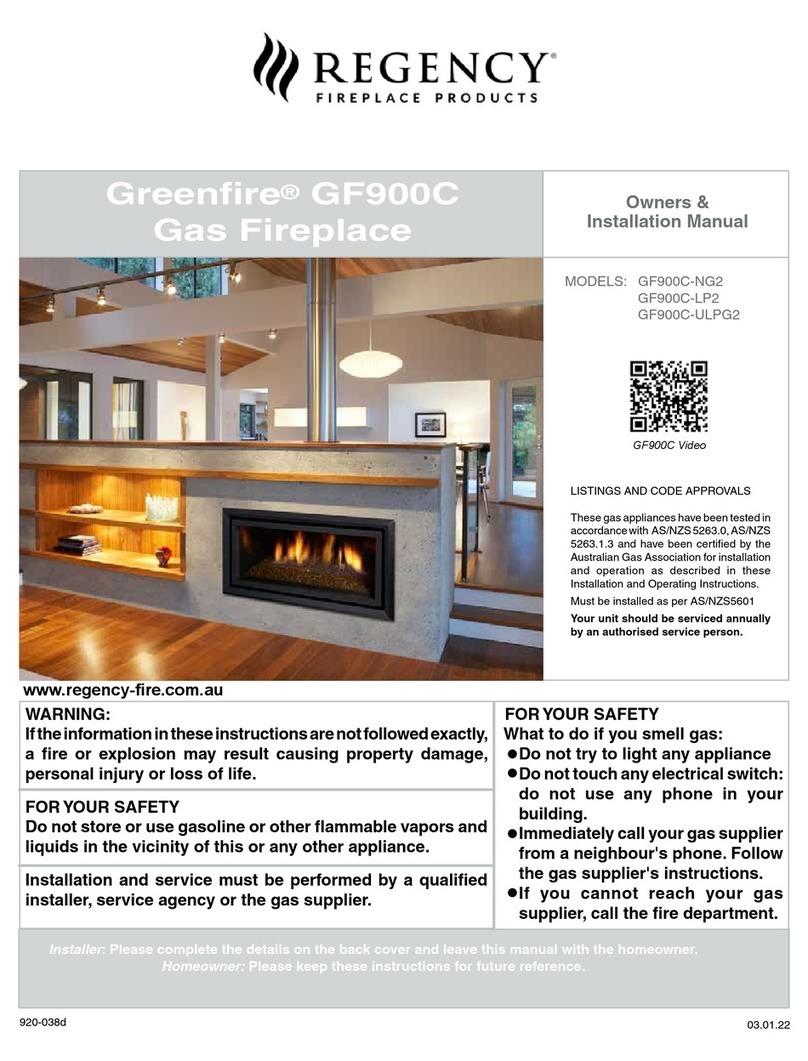
Regency
Regency Greenfire GF900C Owners & installation manual
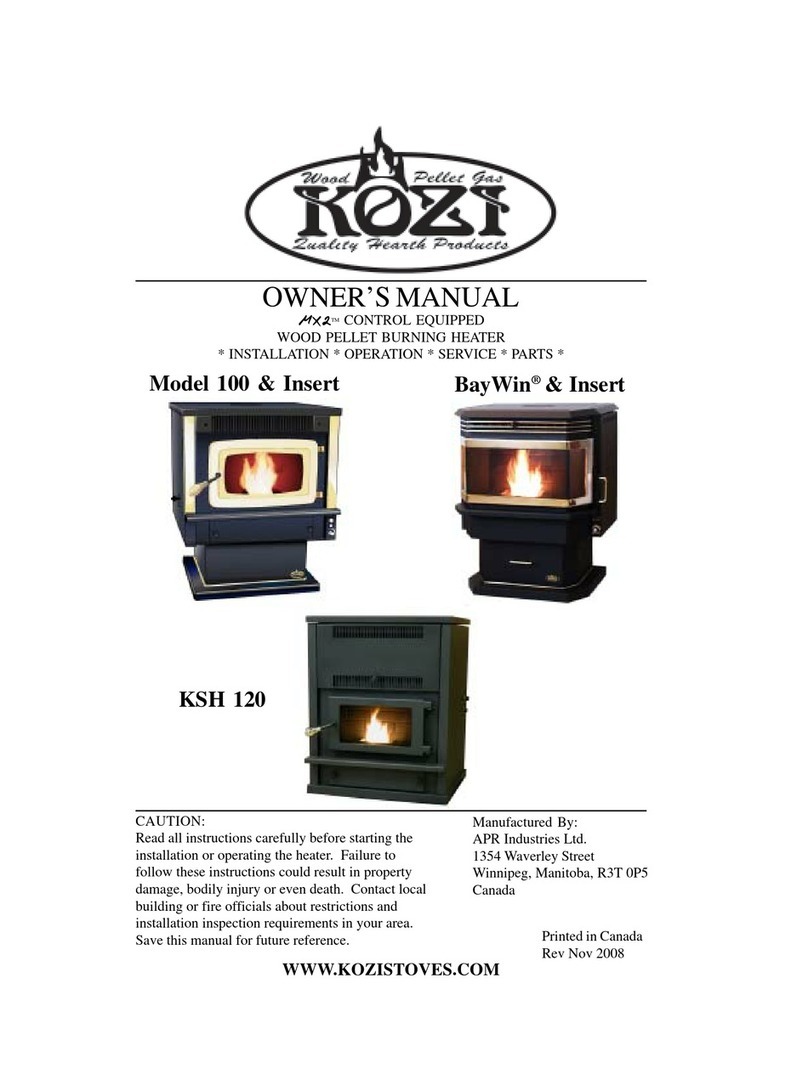
Kozi
Kozi 100 & Insert owner's manual

Faber
Faber CASSETTE 400 manual
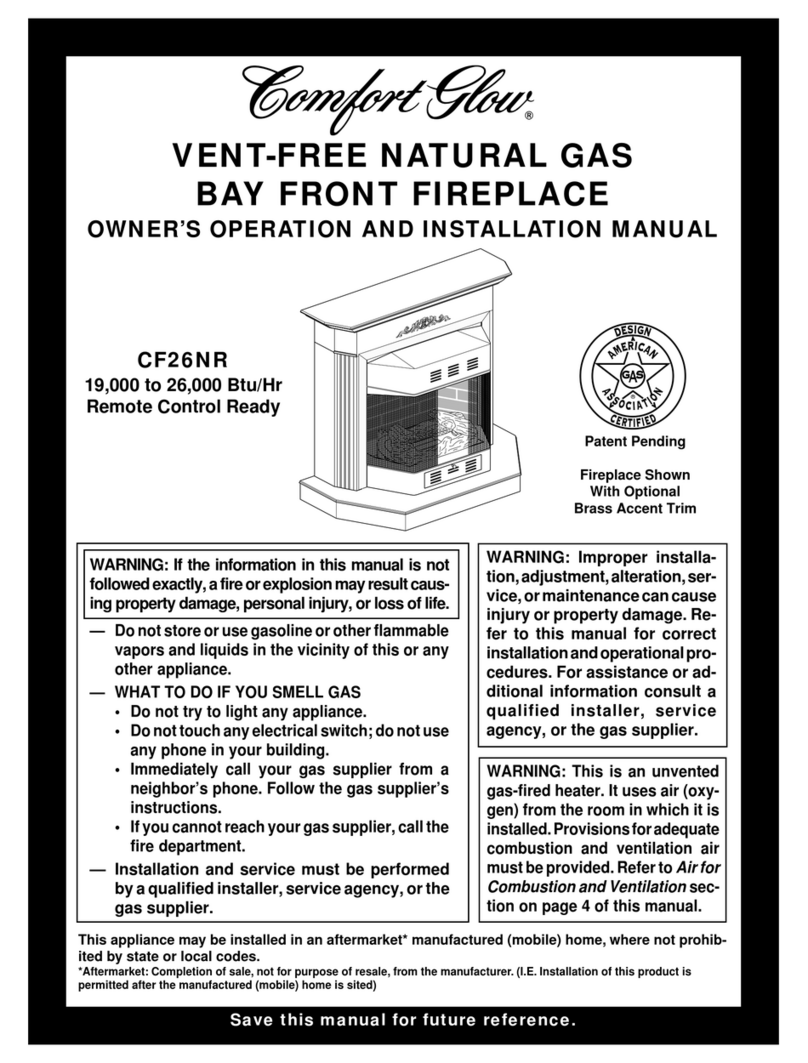
Comfort Glow
Comfort Glow CF26NR OWNER'S OPERATION AND INSTALLATION MANUAL
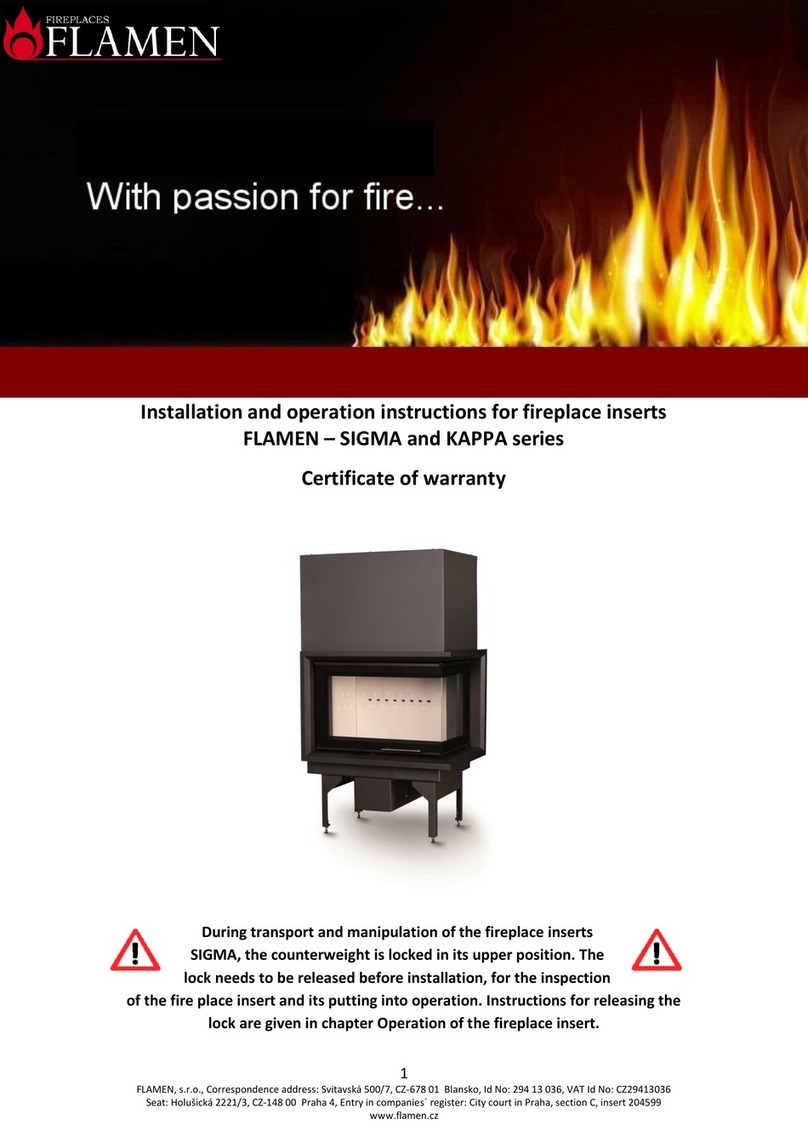
FLAMEN
FLAMEN SIGMA Series Installation and operation instructions for fireplace inserts

barbas
barbas Unilux-7 67 user manual

NetZero
NetZero Waterplace Series installation manual
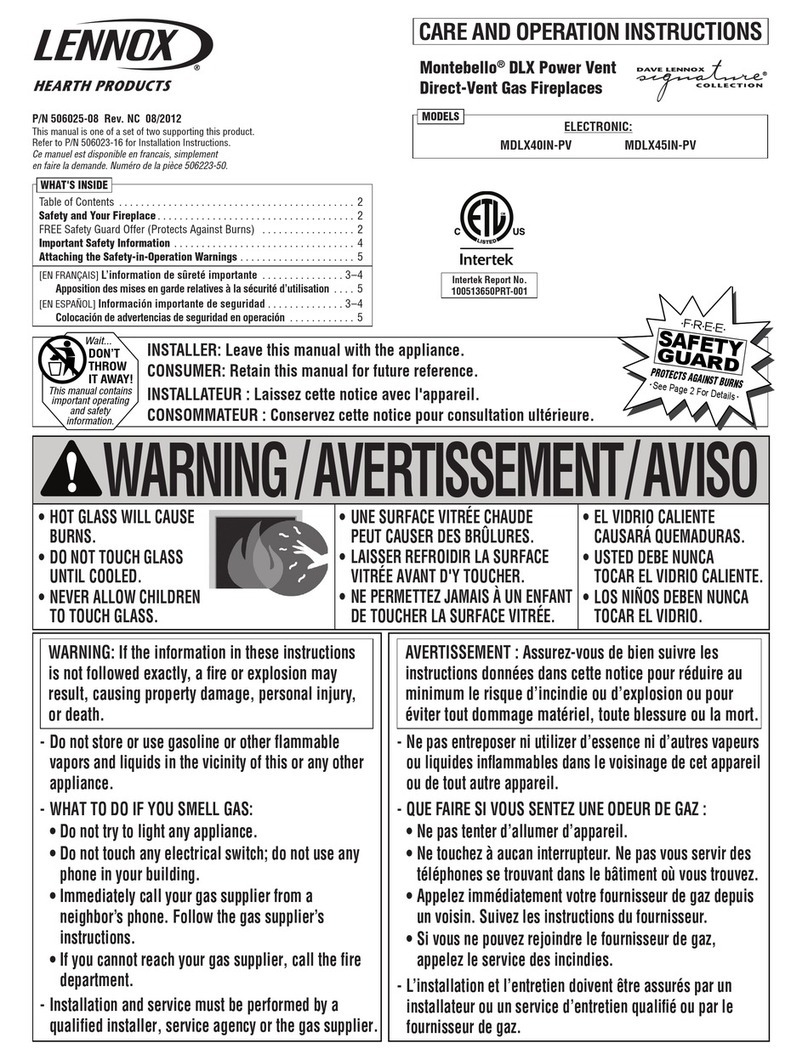
Lennox
Lennox Montebello MDLX40IN-PV Care and operation instructions
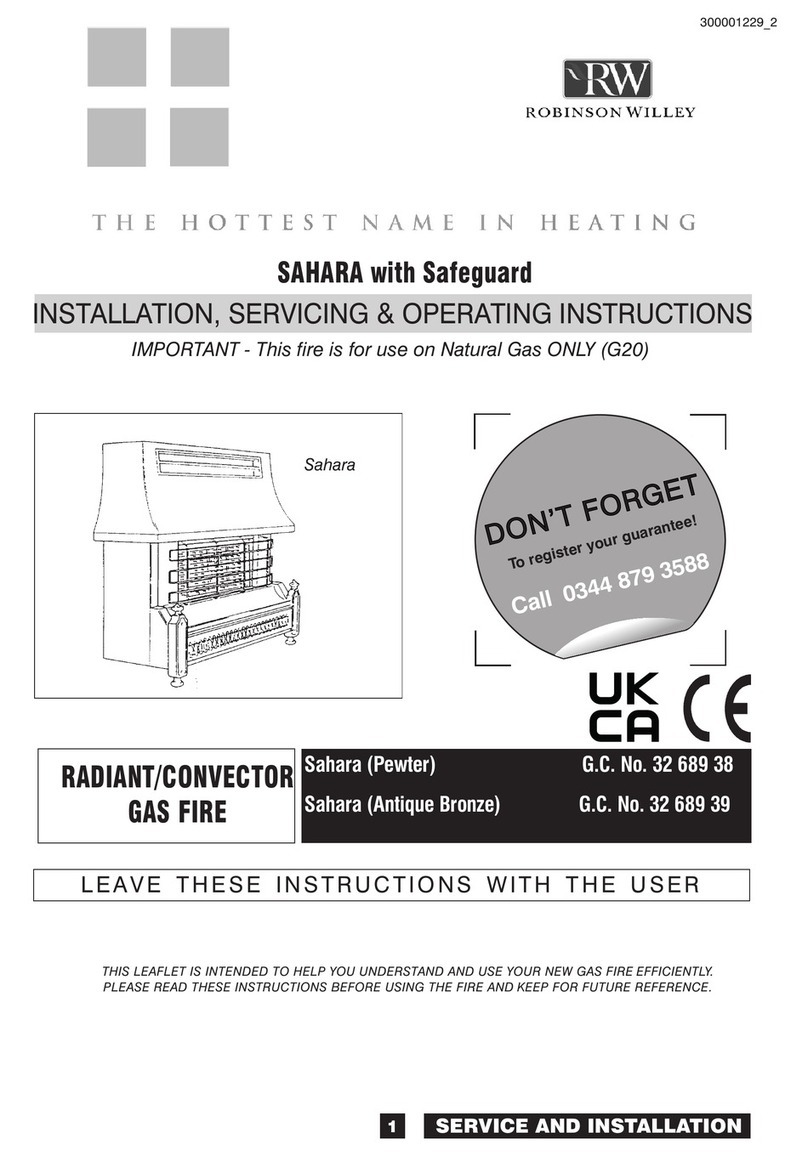
Robinson Willey
Robinson Willey Sahara Installation servicing & operating instructions

Heatilator
Heatilator CL36D Installation & operating instructions
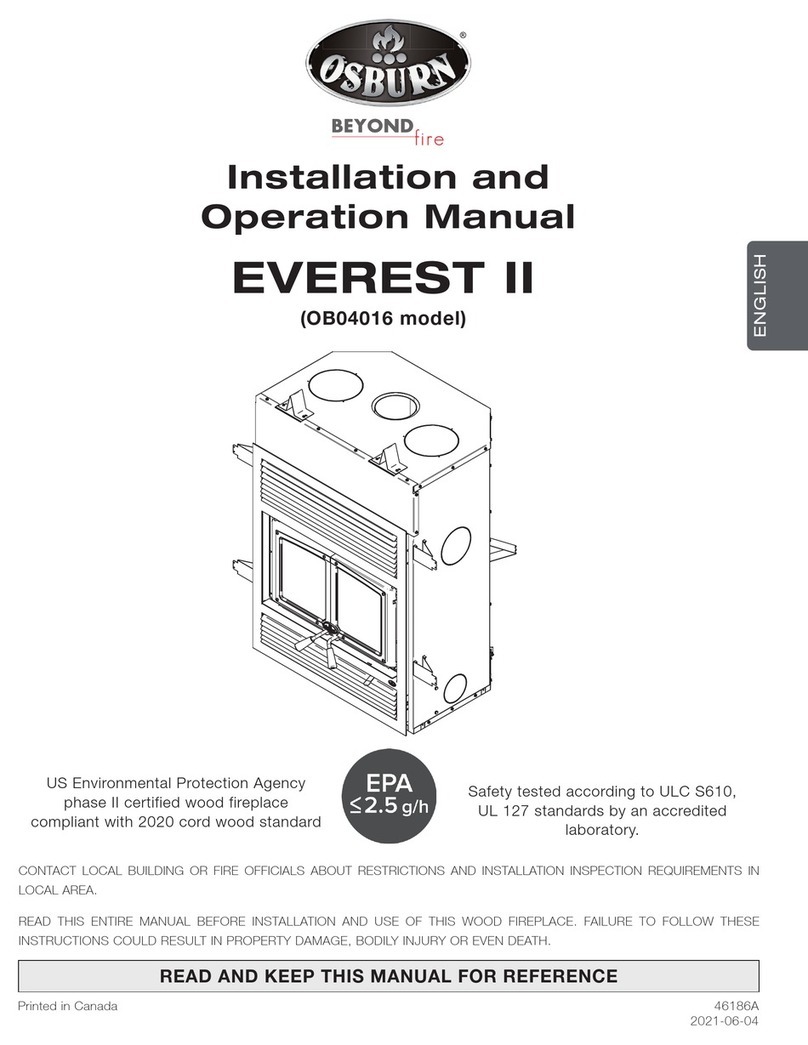
Beyond
Beyond OSBURN EVEREST II Installation and operation manual
